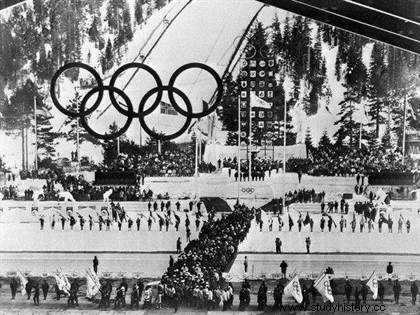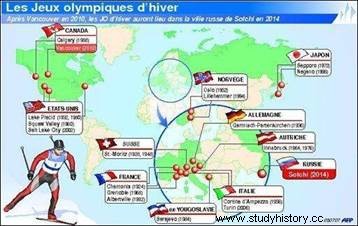 The first Winter Olympics took place in France, in Chamonix, in 1924. Sixteen nations and more than 250 athletes took part and competed in five events. This snow and ice sports competition is now held every four years and forms a separate cycle from the Olympic Games. They have less awareness than the Summer Olympics, making half as much revenue, being much more difficult to organize due to geography and weather vagaries. They remain one of the most important cultural events in our history, touching billions of people on earth with always the same thought “always bigger, always stronger”.
The first Winter Olympics took place in France, in Chamonix, in 1924. Sixteen nations and more than 250 athletes took part and competed in five events. This snow and ice sports competition is now held every four years and forms a separate cycle from the Olympic Games. They have less awareness than the Summer Olympics, making half as much revenue, being much more difficult to organize due to geography and weather vagaries. They remain one of the most important cultural events in our history, touching billions of people on earth with always the same thought “always bigger, always stronger”.
The origin of the Olympic Games
The first ancient Games were celebrated from 776 BC. AD, dedicated to the Greek gods and taking place in Olympia until 393 AD, when Emperor Theodosius I abolished them. In Olympia, temples and monuments rubbed shoulders with palaestras and gymnasiums, as well as places of training and accommodation. During the Olympics of that time, young people proved their physical quality as well as their good relationship with others. The sacred fire burned permanently on the spot, in the middle of the sports sites symbol of our current Olympic flame. The winner of each event was applauded, received a palm, ribbons tied around his head and his hands. At the end of the Olympics, the judges placed an olive branch wreath on the head of the Olympic winner.
 Pierre de Coubertin, born in Paris in January 1863 and died in Geneva in September 1937, was very attached to sport and decides one day in winter 1892 to restore the Olympic Games, but no one believes in it given the magnitude of the task, especially since sport was considered a frivolous activity, detrimental to knowledge and intellect. We must renovate the ancient games, found an organizing committee and launch an international movement.
Pierre de Coubertin, born in Paris in January 1863 and died in Geneva in September 1937, was very attached to sport and decides one day in winter 1892 to restore the Olympic Games, but no one believes in it given the magnitude of the task, especially since sport was considered a frivolous activity, detrimental to knowledge and intellect. We must renovate the ancient games, found an organizing committee and launch an international movement.
The Olympic Congress of April 16, 1684 therefore allowed Baron de Coubertin to found the first International Olympic Committee (IOC) on June 23. Happy, he will lead this institution for thirty years, until 1925. The first Olympic Games can open again and Athens is designated to organize them in April 1896. During this Congress, it was decided not to make any Separate Olympic Games, but the host country could set up winter sports competitions under the patronage of the IOC, if its geography and infrastructure allowed it.
The International Olympic Committee (IOC)
The IOC initially chaired by a Greek, acts as the supreme authority, ensuring the regular organization of the games, promoting sport among young people, encouraging the Olympic values so that courtesy reigns and violence is banished, supporting the promotion of women for equality between men and women, fighting against doping among athletes, ensuring the expansion of host cities and countries.
Thus the Olympic Charter explains “Olympism is a philosophy of life, exalting and combining in a balanced whole the qualities of body, will and mind. Combining sport with culture and education, Olympism seeks to create a lifestyle based on joy in effort, the educational value of good example and respect for universal fundamental ethical principles" and " the most important thing in the Olympic Games is not to win but to participate, because the important thing in life is not the triumph but the fight; the main thing is not to have won but to have fought well”.
The first Winter Olympics
Before the Winter Olympics existed, Sweden had already organized its first international "multi-sport winter" competition in 1901. The Nordic Games sponsored by one of the members founders of the IOC and friend of Coubertin, took place in 1903 and 1905 then every four years until 1926. In 1912, the Summer Olympics were to take place in Sweden and the IOC secretary Eugenio Brunetta d'Usseaux asked include a week of winter sports; the proposal is refused but accepted for the 1916 Olympics in Berlin. Finally, everything will be canceled because of the First World War.
The Olympics resume after the war, in Belgium, including figure skating and ice hockey. Then France was designated to organize the Summer Olympics in 1924, with authorization to constitute a separate “international winter sports week”. Chamonix hosted in January 1924, sixteen events over eleven days, including figure skating, Nordic combined, ice hockey, curling and bobsleigh, receiving more than 250 athletes. A year later, the IOC officially decreed that the first Olympic Winter Games were held in France in January 1924.
Some highlights of the Olympic Games
The second Olympic Games of 1928 in Switzerland welcomed 25 countries and 464 athletes who took part in 14 events despite the deplorable weather conditions. The blizzard is present at the opening ceremony, the 50 km cross-country skiing event takes place in temperatures ranging from 0° to 25°, the speed skating events are purely and simply cancelled.
The 1932 Olympics move away from Europe and take place in the state of New York. As a result, only 252 athletes represent 17 countries. The American Eagan goes down in history:after winning gold in boxing at the Summer Olympics in 1920, he again won gold in bobsleigh. The medal ceremony takes place for the first time on a podium. February 1936 is the month of upheavals during the Olympic Games in Germany in Garmisch-Partenkirchen. Professionals being excluded from the events, the Swiss and Austrians are boycotting the ski events.
 The Second World War is here, the Olympic Games will not take place in 1940 nor in 1944. As a result , for the first post-war Olympics in 1948 in Switzerland, the Germans and the Japanese were not invited. Despite the verifications made by the IOC, two American hockey teams present themselves and claim to be the national team of the country. The Olympic Games sessions of the following years will be “first times”:in 1956 in Italy broadcast on TV; the Soviet Union enters the Olympics; in 1960, California saw the arrival of women's biathlon and speed skating, the Olympic village and the computer to compile results; in 1968 in France the 1158 athletes from 37 countries are seen in color all over the world on TV; in 1976, Austria presented the official Winter Olympics mascot.
The Second World War is here, the Olympic Games will not take place in 1940 nor in 1944. As a result , for the first post-war Olympics in 1948 in Switzerland, the Germans and the Japanese were not invited. Despite the verifications made by the IOC, two American hockey teams present themselves and claim to be the national team of the country. The Olympic Games sessions of the following years will be “first times”:in 1956 in Italy broadcast on TV; the Soviet Union enters the Olympics; in 1960, California saw the arrival of women's biathlon and speed skating, the Olympic village and the computer to compile results; in 1968 in France the 1158 athletes from 37 countries are seen in color all over the world on TV; in 1976, Austria presented the official Winter Olympics mascot.
The Olympic Winter Games were held every four years from 1924 to 1992. From that date, the International Olympic Committee (IOC) decided to implement an interval of two years between these events; this is why the Winter Games were held in 1994 in Lillehammer (Norway), two years before the Summer Games in Atlanta (Georgia, United States).
The different events
Initially in 1924, the events involved bobsleigh, cross-country skiing, ski jumping and Nordic combined, curling, figure skating and ice hockey. Skeleton appeared in 1928, followed by alpine skiing in 1936. After the war, biathlon in 1960 and luge in 1964 were added to the Olympic Games. It was not until the 1990s that new, more innovative disciplines made their Olympic debut, such as freestyle skiing in 1992 and snowboarding in 1998.
These days, the events of the Winter Olympics are divided between snow sports and ice sports. Are thus present, for snow sports, alpine skiing (downhill, special slalom, giant slalom, Super-G and combined, mixed), cross-country skiing (individual, pursuit and relay, mixed), Nordic combined (individual and team, men), ski jumping (individual and team, men), biathlon (individual, team and relay, mixed), freestyle skiing (moguls and springboard, mixed) and snowboarding (half-pipe , giant slalom and snowboard cross since 2006, mixed).
In the category of ice sports are ice hockey (mixed), figure skating (individual, pair and dance, mixed), speed skating (individual, pursuit team, mixed), short track speed skating (short track in English, individual and relay, mixed), luge (single, mixed, two-seater men), bobsleigh (two-person team, mixed, and four-person team , men), curling (mixed) and skeleton (mixed).
The future of the Olympic Winter Games
Several times during the Winter Olympics, there was a lack of snow and the cannons were very useful to cover certain slopes. With global warming, we can ask ourselves even more questions. The Austrian University of Waterloo and scientists from the Canadian Research Center carried out a long study on the consequences of this warming for the winter sports resorts that have hosted the Olympic Games since 1924 and concluded "at the rate at which the earth continues to warm up, many venues would no longer be able to support competition.” What will become of the Winter Olympics?
